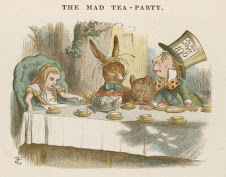'Independents' tend to break out along party lines as there are only two parties, and that when a third party is introduced 'Independents' will then break in a tripartite fashion. What comes out of this is that when non-voters or 'Independents' move to a new standard, they have the effect of changing the 'Independent' voting ratio . . .Read the whole thing.
With a third choice and Independents falling out proportionately, an era of 'bi-partisanship' ends: a third party that kept to a small government platform and did NOT compromise, while a minority, would demonstrate that the other two parties were either in collusion (i.e. 'bi-partisanship' against the third party) or unwilling to compromise THEIR power structure so as to reduce government (via the number of agencies, regulations, personnel, legal coverage, etc.). A small, hard-line party that is able to garner 20% of the vote becomes a palpable threat to the 'two party system' . . .
By increasing the pool of voters and having them committed to a third party or alternative voting arrangement, what had once been 'safe' seats become, at an instant, plurality seats only . . . that very change is a POSITIVE feedback to the third party members in that THEY did this, they entered into the fray and changed the cozy arrangement that had been set up between the two parties for 'safe' districts. While 46% is still a 'win' it is not a 'safe' win and indicates weakness in the two larger pluralities that can be exploited by a lean and hungry third party . . .
And if a third party can bring IN any of the current disaffected, their power is magnified by doing so. The existing two parties have had four decades to stem that tide and have not succeeded. Getting the current voting disaffected is not enough: any third party must reach out to the self-disenfranchised and give them a positive reason TO vote. Republicans and Democrats have failed miserably at that, and any third party that can get any success will crack the two party system wide open.
A Jacksonian Strategy to Break the Democratic-Republican Duopoly System of Government
The Jacksonian Party builds on an analysis from last spring, Third Party Outlines, which persuasively argued for a third party or independent strategy that attracts voters away from the major parties while reaching out to non-voters. Other Roads begins from an analysis of recent polls showing significant support for a third party alternative to the Democratic-Republican charade and argues that even a minimal activation of non-voters in favor of such an alternative would radically alter the strategic calculus of the duopoly order. Some key points:
Subscribe to:
Post Comments (Atom)


No comments:
Post a Comment